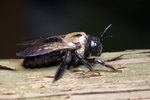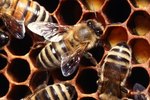
While you might receive a nasty sting from either a wasp or bee, they're quite different insects. While bees consume pollen and plant nectar, wasps eat other insects. For the most part, these creatures reside in types of structures made of dissimilar materials. Wasps usually build nests, while honey bees move into or construct hives.
Wasp Nests
Wasp's nests vary according to the species. Yellow jackets, among the most common types of wasp, create nests by chewing wood fiber. Wasps round the resulting pulpy substance made from a mix of fiber and their saliva into combs stacked on top of each other. The nest is then covered with additional pulp. Wasps prefer nesting in secluded areas, including trees and hedgerows. If you find wasp's nests in buildings -- especially under eaves and beams -- they likely belong to the paper wasp. These nests lack the additional pulp covering of other wasp species, so you see the actual comb.
Beehives
Hives refer to either man-made or bee-made structures. Farmers raising honey bees place artificial hives in fields so bees can pollinate plants and create honey combs. Worker bees are in charge of building natural beehives. Their bodies secrete wax, which the bees chew on and add to the hive's construction. The finished hive consists of six sides, ideal for honey production and storage. While honeybees might occupy a suitable hive for years, bumblebees often nest in the ground and build a new dwelling each season.
References
Photo Credits
-
Jupiterimages/liquidlibrary/Getty Images
Writer Bio
Jane Meggitt has been a writer for more than 20 years. In addition to reporting for a major newspaper chain, she has been published in "Horse News," "Suburban Classic," "Hoof Beats," "Equine Journal" and other publications. She has a Bachelor of Arts in English from New York University and an Associate of Arts from the American Academy of Dramatics Arts, New York City.




